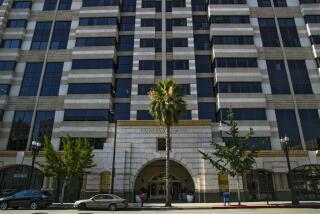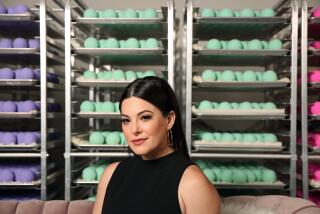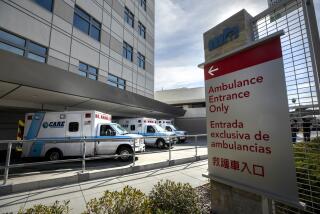Making a Miracle : Biotech: When Donald M. Earhart took over five years ago as chief executive at I-Flow Corp., the Irvine company was on the verge of going under. Now it’s making a profit.
- Share via
IRVINE — One small biotech company is having the sort of year many only dream of.
After a decade of losses, I-Flow Corp. is making money.
“It’s a miracle,” says Donald M. Earhart, the company’s chief executive, who recalls that the company was on the verge of disappearing many times.
Earhart, 51, was hired to fix the company midway through 1990, its bleakest year. It had gone public in February that year, he says, only to discover within weeks that the high-tech gizmos on which it based its offering didn’t work.
Several of the items, computer-based infusion pumps intended for patients on intravenous drugs, went haywire in tests on dogs and started beeping like a microwave.
After Eric W. Brown resigned as chief executive, I-Flow recruited Earhart, an experienced executive with an engineering degree, medical industry background and combative style.
In his five years there, through trial and error, Earhart pieced together a new lineup of products. He ordered his engineers to rework the original pump. He pushed them to come up with cheap, “low-tech” alternatives.
All the while, he kept buttering up investors. With the company perennially short of cash, he managed to sustain it by raising a total of about $20 million in five stock sales to private investors.
*
Earhart, a former divisional president of Irvine-based Allergan Inc., made investors his first priority. A week after he joined I-Flow, he flew to New York, London and Paris to meet with investors. He says he wanted to make sure none were mad enough to sue over failure of the original prototype. He also realized that he would probably have to approach them again to seek more money.
In London, a Parisian investment banker flew into a rage over reports of the prototype’s failure, Earhart recalls. The man calmed down, Earhart says, when he promised to shut down the company and give investors anything that was left if he couldn’t turn I-Flow around.
Persuaded that nobody would sue, possibly because the company had so few assets, Earhart returned to Irvine to work on I-Flow’s product.
He studied the original pump: a programmable device, somewhat larger than a video cassette, designed to deliver four drugs intravenously to a cancer patient on chemotherapy. The pump came with a separate programming device, about the size of a laptop computer.
The product, he discovered, had problems. Meant for cancer patients, it wasn’t geared to serve the larger number of patients on intravenous antibiotics, pain medicine, or nutrition.
Nurses tending homebound patients also found the product too complicated. They weren’t used to dealing with computers and didn’t want to lug the programmer with them to patients’ homes.
“We’re in big trouble,” Earhart told an associate. “We’ve got a product nobody wants.”
Earhart sent his engineering staff back to the drawing board to design a pump that most patients could use. And he wanted a device that could be programmed over phone lines via a remote computer at a pharmacy.
Inevitably, more glitches occurred, costing delays and money. Earhart started appearing at engineering meetings, wearing a military camouflage helmet and carrying a fake grenade, says his engineering manager. The implied message: “No more bombshells.”
In December, 1990, a new prototype made its debut at a Las Vegas trade show, attracting throngs around the company’s display booth, Earhart says. But the device failed during demonstrations.
“We were sweating bullets,” he recalls.
Still, the prototype proved the company had life, and investors agreed to put up $5.5 million in 1991, when the company was nearly out of money. “It got the boys in New York, London and Paris excited,” Earhart says.
By then, however, Earhart figured the product, called “Vivus 4000,” couldn’t sustain the company.
He decided to go low-tech in search of a cheaper pump. Eschewing electronics, and even batteries, he asked his engineers to come up with a simple, mechanical device that could squeeze a drug-filled drip bag. And he wanted the pump to be reusable, so it would be cheaper than disposable devices on the market.
The result: a pump dubbed “Sidekick,” which a patient could load with a bag then easily screw shut. The pump sold for $10 and could be reused countless times.
While the high-tech Vivus 4000 continued to be plagued by low sales, the company’s Sidekick and other low-tech items began taking off. In the fourth quarter last year, the company posted its first quarterly profit--$47,000--on sales of $2.9 million. And the company, which lost more than $12 million the last four years, should have its first profitable year in 1995. An analyst estimated that I-Flow’s earnings this year will be $800,000.
Still, with pressures to reduce costs intensifying across the health care industry, Earhart wanted something even cheaper to sell. That mandate has spawned the Band-It Syringe Driver, a simple device that uses a rubber band to “drive” a 10-cent syringe. The syringe and the device replace the traditional $1 drip bag used to administer intravenous fluids.
“I defy anybody to come up with anything cheaper than a patented rubber band!” says Earhart.
Now the I-Flow executive faces the challenge of sustaining growth. His salespeople still aren’t making their quotas on the Vivus 4000. He must line up better distributors. And he has ideas for more products, but no cash to develop them.
Which means Earhart isn’t relaxing. “What you did in the past,” he says, “nobody cares about.”
(BEGIN TEXT OF INFOBOX / INFOGRAPHIC)
I-Flow Corp. at a Glance
Location: Irvine
Founded: 1984
Number of employees: 65
Product: Infusion pumps for patients on intravenous fluids.
Traded: Nasdaq
Symbol: IFLO
More to Read
Inside the business of entertainment
The Wide Shot brings you news, analysis and insights on everything from streaming wars to production — and what it all means for the future.
You may occasionally receive promotional content from the Los Angeles Times.









